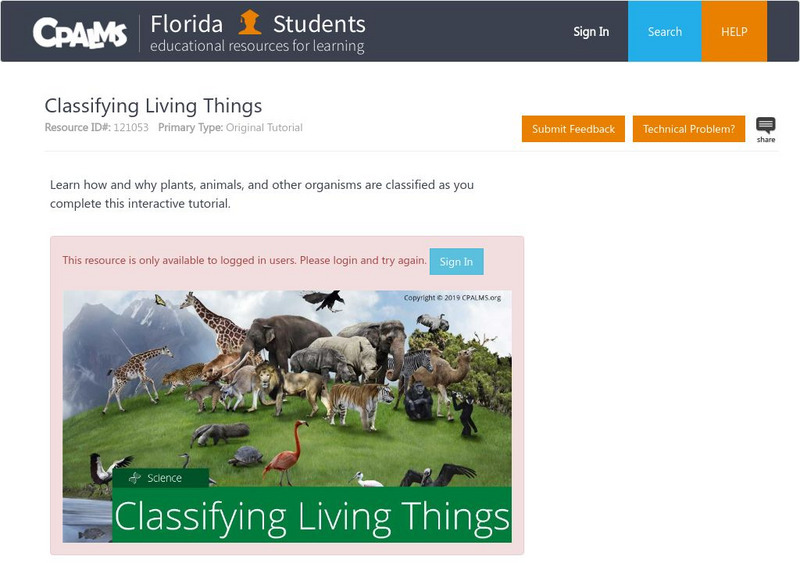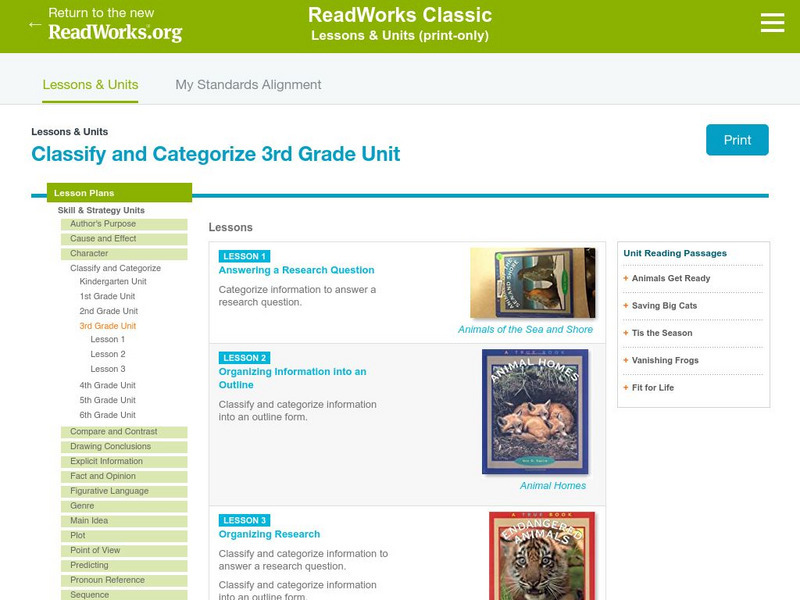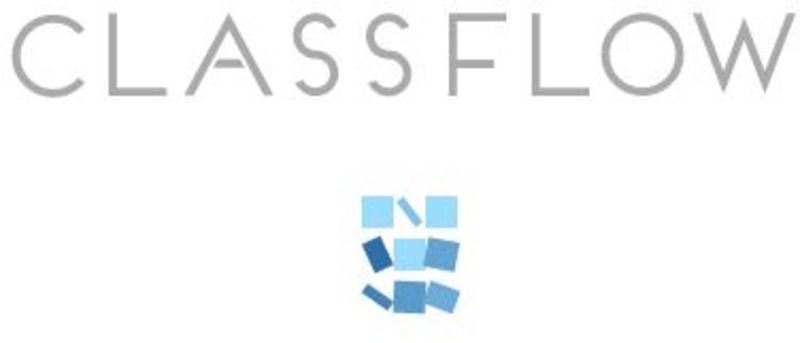CPALMS
Florida State University Cpalms: Florida Students: Classifying Living Things
Learn how all living things are classified.
ClassFlow
Class Flow: Animals Grow and Change
[Free Registration/Login Required] This is a 2nd Grade unit on how animals grow and change. It includes information on life cycles of animals and how to classify animals into groups (i.e. mammal, reptile, amphibian, etc.) There is an...
Read Works
Read Works: Classify and Categorize 3rd Grade Unit
[Free Registration/Login Required] A three-lesson unit on classifying and categorizing through which learners learn how to categorize information to answer research questions and then to organization that information into an outline....
Read Works
Read Works: Classify and Categorize 4th Grade Unit
[Free Registration/Login Required] A three-lesson unit on classifying and categorizing through which students learn how to organize research into an outline, use text features to locate information, and write a research report. Lessons...
Read Works
Read Works: Animals Get Ready
[Free Registration/Login Required] Students read about how different types of animals prepare for winter. A question sheet is available to help students build skills in classifying and categorizing.
ArtsNow
Arts Now Learning: Classification of Animals: "Connect Your Animal Show" [Pdf]
Fifth graders learn about animal classification by reviewing the taxonomy system, then looking at pictures of animals as if they were scientists, acting out an animal's characteristics, then classifying their animal.
ClassFlow
Class Flow: Classifying Critters
[Free Registration/Login Required] This flipchart helps students understand how to classify animals. There are 3 groups in this flipchart - reptiles, fish, and birds. Included in the flipchart are web links, Activote questions,...
Sophia Learning
Sophia: Animals: Vertebrates: Lesson 3
This lesson will explain the characteristics of animals that are classified as vertebrates. It is 3 of 4 in the series titled "Animals: Vertebrates."
Sophia Learning
Sophia: Animals: Invertebrates: Lesson 3
This lesson will explain the characteristics of animals that are classified as invertebrates. It is 3 of 4 in the series titled "Animals: Invertebrates."
Sophia Learning
Sophia: Animals: Invertebrates: Lesson 4
This lesson will explain the characteristics of animals that are classified as invertebrates. It is 4 of 4 in the series titled "Animals: Invertebrates."
Sophia Learning
Sophia: Animals: Vertebrates: Lesson 2
This lesson will explain the characteristics of animals that are classified as vertebrates. It is 2 of 4 in the series titled "Animals: Vertebrates."
Sophia Learning
Sophia: Animals: Vertebrates: Lesson 4
This lesson will explain the characteristics of animals that are classified as vertebrates. It is 4 of 4 in the series titled "Animals: Vertebrates."
Fundación Cientec
Ecologia Y Matematica Entretejidas
Four lesson plans in Spanish for elementary math and science class. Students are required to classify animals and make observations. Offers explanations and detail of the lessons and methodology it is based in.
Discovery Education
Discovery Education: Animal Classification
Use this lesson to help students understand the reasons for classifications and ways that different species are separated.
Science Education Resource Center at Carleton College
Serc: Introduction to Dichotomous Keys
This lesson plan serves as an introduction to the classification of plants and animals or trees. Students will investigate how to classify objects based on their similarities and differences. They will use technical writing to explain...
California Institute of Technology
Infrared Zoo Lesson 1: A Trip to the Infrared Zoo
Students will use infrared images to classify different animals. Students will learn more about infrared imaging and the information it can reveal. This activity is guaranteed to activate great class discussion.
How Stuff Works
How Stuff Works: What's Considered Big Game?
Explains what is classified as big game in hunting, something that depends on where you are hunting, for example, in the U.S. or in Africa. Touches on the business aspects of big game hunting, then looks at hunting regulations in...
ClassFlow
Class Flow: Listening for Sounds
[Free Registration/Login Required] This flipchart has the students working on their listening skills with various activities as well as the alphabet cheer, a Big Book, and classifying people and animals.
ClassFlow
Class Flow: Animal Sorting
[Free Registration/Login Required] This K-2 flipchart is designed to make animal classification fun! Sort the animals into categories and think like a scientist!
Sheppard Software
Sheppard Software: Parts of the Food Chain: Producers, Consumers, Decomposers
Learn how scientists classify different types of organisms in an ecosystem or in a food chain by their role and function as either a producer, a consumer, or a decomposer. Then play a game that tests your understanding of these important...
Other
It's All About What's Inside. Classification and the Tree of Life [Pdf]
In this science lesson, students look at how animals have traditionally been classified in a tree of life diagram by examining the characteristics of plastic eggs. They then analyze the genetic code assigned for each egg and look for...
CK-12 Foundation
Ck 12: Episd: Animal Characteristics
[Free Registration/Login may be required to access all resource tools.] Students will be able to identify and classify organisms that are animals based on recognition of traits presented.
CK-12 Foundation
Ck 12: Episd: Animal Classification
[Free Registration/Login may be required to access all resource tools.] Check out the diverse traits that animals can have that put them into different Phyla to make it easier to classify them.
Curated OER
Science Kids: Science Images: Polar Bear With Cubs
This photo shows a polar bear with two cute cubs sitting in the snow. Polar bears are native to the Arctic Circle and are classified as a vulnerable species. Polar bears are the largest type of bear and also the largest carnivores that...





![Arts Now Learning: Classification of Animals: "Connect Your Animal Show" [Pdf] Lesson Plan Arts Now Learning: Classification of Animals: "Connect Your Animal Show" [Pdf] Lesson Plan](https://d15y2dacu3jp90.cloudfront.net/images/attachment_defaults/resource/large/FPO-knovation.png)














